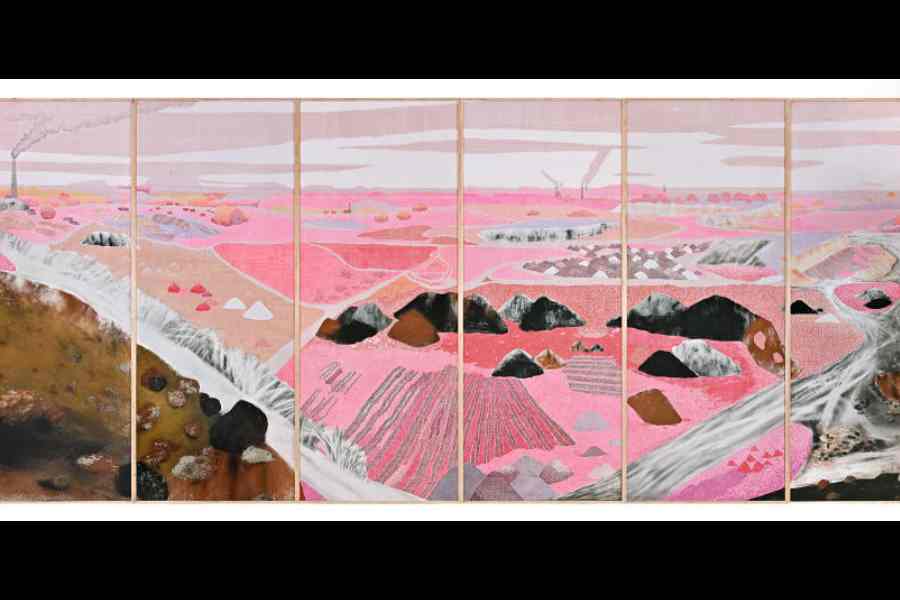T.S. Eliot’s ‘Hollow Men’ are degenerates and disillusioned creatures dealing with a meaningless existence in a wasteland. Even though the title of CIMA’s show, Shape without form, Shade without colour (on view till Dec 21), is taken from Eliot’s poem, the artists exhibited at the show are anything but “quiet and meaningless”. Rather, their canvases erupt with a million mutinies against and scathing criticism of the decaying world we live in.
Samir Aich, for instance, captures the violence of the rape of a doctor at a city hospital but simultaneously also portrays the voices that thundered against injustice and ineptitude of the police. But Rameshwar Broota shows that the humans who are part of law enforcement are just cogs in the wheel of the State machinery. Prashant Patil’s sketches of Non Humans, their lines as fine as the cobweb-like hot glue compositions he usually conjures, indict the dehumanising of those who toil for their daily bread by reducing the body to tools of the trade like a fishing net or a cart. In the same vein, Atul Dodiya’s Man with Chakki is a crisp socio-political manifesto against the degrading life under capitalism.
It is not surprising that in a world where human lives have no value, the Earth itself is wrecked. Kingshuk Sarkar’s Barood is the visceral aftermath of an explosion and while Suman Chandra’s landscape might seem perfectly mapped and pristine at first glance, it is, in fact, a geography that has been ravaged by human greed and mining (picture). Ankan Bandopadhyay’s Andrew Wyeth-esque frames capture steps that take a land from wilderness to wasteland. Bahuleyan C.B.’s vision is post-apocalyptic but marked with a tinge of hope as shades of green penetrate an abandoned city. There is no such respite in Soham Gupta’s Eden where the city is taking its dying breaths or in Shailendra Kumar’s Jalasen Ghat where the black, inky sky and the cramped quarters of Varanasi generate a sense of claustrophobia. It would be the perfect setting for the unclaimed dead body in Bimal Kundu’s Poison or Jogen Chowdhury’s Monument to the Dead, which shows perhaps one of the hundreds of bodies that arrive at Varanasi’s ghats every day. Bikash Bhattacharjee’s Visharjan depicts another kind of ghat, one where the goddess is being immersed, but it is as disconcerting as it takes a grim view of the state of women in the land that worships many female deities. Somnath Hore’s sculptures and sketches of the bodies eaten away by the famine are potent reminders of a past that might recur given the ever-widening chasm between the rich and the poor whose cry for help is eerily captured by Chittrovanu Mazumdar.
The state of humans in these cruel cities is pitiful but especially acute is the status of women. Jaya Ganguly’s women are contorted with the weight of societal expectations and Arpita Singh’s Woman Changing Clothes has the protagonist at her most vulnerable, stripped down to her skin and putting on an armour to face the world. Cleverly skirting Singh’s work like a frame is Swarna Chitrakar’s patachitra of the many roles a woman plays in society. Sonal Varshneya’s Kissa Goi, too, captures the minutiae of feminine lives while Sudhir Patwardhan ponders the alienating experience of a Muslim woman who bears a double burden of marginalisation. Rashmi Bagchi Sarkar, on the other hand, conjures up a modern-day woman in the image of Bharatmata.
Interesting parallels can be found between the works of, say, Ram Singh Urveti and Sudhakar Chippa. In his inimitable style, the Gond artist shows the battle for Swadhinta but does this also become a battle against traditions and a freedom from an Elysian world? What does such ‘freedom’ entail? Chippa focusses on the result of the tussle, showing outmigration towards a lifeless city. The wild freedom of Madhuri Kapur’s Kafkaesque Bird makes the captivity of Shreyasi Chatterjee’s Caged delicate avians seem all that more painful. When death comes knocking in M.F. Husain’s Knight Watch and Ganesh Pyne’s Bhimsen and Ghatothkatch, it leaves viewers chilled to the bone.










